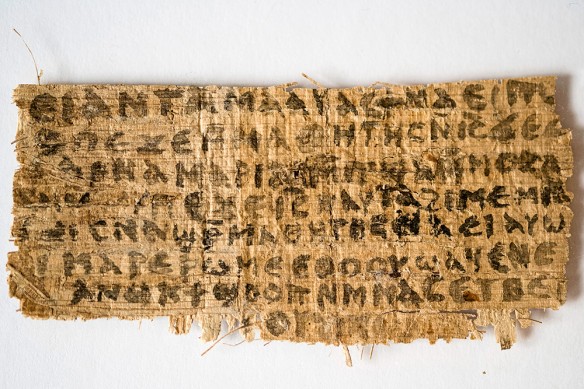Karen L. King provides an analysis and discussion of a 4th century AD scrap of papyrus written in Coptic. The phrase “Jesus said to them, my wife” is the most interesting text as it supports the idea that Jesus was married. Her paper is available here. The fragment with translation and transliteration can be found here.
An analysis of the impact of the phrase is found here. Alan Boyle, author of the piece, suggests that the fragment represents Gnostic Christianity rather than Orthodox Christianity.
Some reflections by Evangelical Darrell Block here.
A couple of things to note:
1- The text as we have it is from the fourth century AD–though the original may be earlier. It tells us what some Christians of that period thought of Jesus, but does not necessarily tell us about Jesus of the first century.
2- It is a small fragment, without any context, making it very difficult to interpret.
3- The earliest first century documents about Jesus say nothing whatsoever about his marital status.




The fact that Jesus “never” spoke of his wife possibly could be the same reason why Heavenly Father never speaks of Heavenly Mother-respect for his wife. Jesus was the perfect example in all things so naturally we have to assume that he was married and these documents that mention his wife shouldn’t be the surprises they are. Christ’s apostles were married as we know and the places where Christ speaks about celibacy were specific cases where that particular person would be better not remarrying to fulfill the higher law of chastity that we don’t even live in today’s Mormonism. I refer to not being able to remarry after one divorces. Celibacy is a false interpretation for what Christ was teaching. Especially since modern revelation states we can’t attain the highest degree of the Celestial Kingdom without being sealed in the temple, obviously Christ is there, so he has to be married, he’s the one that stated the scripture through his modern prophet (D&C 131:1-4).
If there is anything alleged Mormons should have learned about Hofmann-sized scraps of paper, it is that: (1) it is an easy modern forgery, (2) it is a potential contemporary or early forgery, or (3) it was written by someone else with the popular name Jesus.
April DeConick from Rice University has a very good post regarding the fragment, as well. She puts it into a Valentinian Gnostic context. See here.
“But let’s keep in mind that we actually already have a text that mentions Jesus’ wife. It is the Gospel of Philip. We already know that there were some early Christians, in particular the Valentinian Gnostics, who taught that Mary Magdalene was Jesus’ consort or wife. They wrote about it in the Gospel of Philip.
“The reason that their tradition remembered Mary in this way is because they believed that marriage was the sacred creative activity of God and God’s manifestations or Aeons. They also believed that their own human marriages were reflections – what they called “an image” – of the eternal marriages of the Aeons. Jesus’ human marriage to Mary Magdalene was believed to reflect the sacred marriage of the Aeons Jesus and Sophia.”
Note that for many Gnostics, Jesus the mortal and Jesus the Aeon (aka Christ God) were two separate beings. That the earthly marriage reflected the eternal marriage of the Aeons or divine beings does have interesting connotations in light of LDS view of eternal marriage.